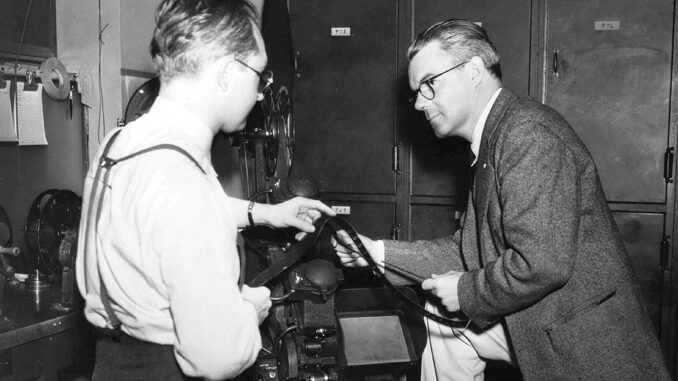
by Edward Landler
Picture editor Irving James Wilkinson has unfortunately become the most obscure of the three original founders of the Society of Motion Picture Film Editors (SMPFE). Many sources, including the Guild’s own historical records (which were cited in the story on the beginnings of the SMPFE in the JAN-FEB 12 issue of this publication) had him confused with a similarly named contemporary, the sound editor James R. Wilkinson.
But the I. James Wilkinson who is documented as a founding member of what is now the Motion Picture Editors Guild was the head of RKO Radio Pictures’ editorial department from 1931 until the studio folded in 1957, as verified by his Variety obituary and early volumes of the International Motion Picture Almanac. His early career proved to be a fascinating journey that traced the growth of the motion picture industry in Hollywood.
Wilkinson was born on January 22, 1897, in Los Angeles. Straight out of high school in 1913, he worked as a film booker for the Film Exchange. After a short stint as a film inspector for the Mutual Film Company in 1915, he became an assistant director and film editor for the Signal Film Company. He spent three years at Signal, working his way up to head editor for the studio, and cut all the serials and features produced there that starred Helen Holmes. Holme shad become famous earlier in the decade as the star of The Hazards of Helen (1914-17) cliffhanger serial and became identified as a self- reliant heroine in railroad settings. At Signal, Wilkinson cut pictures for her with titles like The Girl and the Game (1915), Medicine Bend (1916) and The Railroad Raiders (1917). He also found the time in 1917 to manage a movie theatre in the Tropico neighborhood of Glendale.
From 1918 to 1921, Wilkinson was a film editor and assistant director at Universal Pictures, where he worked with director Christy Cabanne, who had been an assistant director under D.W. Griffith. Wilkinson moved to Robertson-Cole Pictures in 1921 where, in the same year, he edited some of director Henry King’s early films — Salvage, The Sting of the Lash and The Mistress of Shenstone — all starring Pauline Frederick, a prominent stage star who became a major silent movie star.
Wilkinson was still with Robertson-Cole when itbecameFBO(FilmBookingOffices)in1923. In 1926, financier Joseph P. Kennedy — father of future president John F. Kennedy — acquired the company. But Wilkinson went to work for Paramount Pictures in 1927, where he served as chief film editor and production supervisor.
During his time at Paramount, Wilkinson became a member of the Technicians branch of the newly founded Academy of Motion Picture Arts and Sciences (AMPAS). In July 1930, an article written by MGM production head Irving Thalberg, in his role as Chairman of AMPAS’ Producers branch, appeared in the Journal of the Society of Motion Picture Engineers (now SMPTE; the ’T’ was later added for Television). Thalberg’s article described the initial technical projects undertaken by the Academy.
Wilkinson was on a committee assigned to establish industry-wide standards for the makeup of release prints. The committee prepared a detailed blueprint and two sample reels to demonstrate their standards for preparing leaders and changeover signals. The studios adhered to these standards until the 1950s, when the updated Academy Leader specifications were introduced.
While Wilkinson was still at Paramount, FBO and the Keith-Albee-Orpheum theatre chain merged under the control of RCA (Radio Corporation of America) and, in 1929, became RKO Radio Pictures. In 1932, he was called back to RKO by then-production chief David O. Selznick to head its editorial department. He remained in that position through four changes of ownership — including the disastrous management of Howard Hughes — and under 10 different production chiefs. He retired with the studio’s demise shortly after the General Tire and Rubber Company bought Hughes out in 1957.
During Wilkinson’s tenure at RKO, the studio turned out such classics as the original King Kong (1933), the Fred Astaire-Ginger Rogers musicals, Bringing Up Baby (1938), The Hunchback of Notre Dame with Charles Laughton (1939), Gunga Din (1939), Orson Welles’ Citizen Kane (1941) and The Magnificent Ambersons (1942; cut to two-thirds its original length by the studio), the Val Lewton unit’s low-budget thrillers including Cat People (1942) and I Walked With a Zombie (1943), Alfred Hitchcock’s Notorious (1946), Out of the Past (1947), John Ford’s Fort Apache (1948) and She Wore a Yellow Ribbon (1949), The Thing (1951) — and the list goes on and on.
Active in the SMPTE throughout his career, Wilkinson presented a paper on “Motion Picture Editing” in the Society’s Hollywood headquarters at its fall 1940 meeting. The paper began by noting the absence of significant published material about the editing phase of motion picture production. He may not even have been aware of the few essays on montage by Russian director Sergei Eisenstein that had already been translated into English.
Then, drawing from his own work experience, Wilkinson mapped out editing’s origin as a purely mechanical craft in nickelodeon days and its growth into a vital dramatic element of movies as they grew into feature- length attractions projected in movie palaces. At the close of his presentation, he screened a reel of film that he had prepared to demonstrate “the technics [sic] of cutting for dramatic effect and shock, and cutting to rhythm and tempo.”
Published in SMPTE’s Journal in January, 1941, Wilkinson’s paper concluded with this perspective on the editor’s work:
“A director often spends months shooting a picture, and weeks cutting it. Then he previews it. In reel 2, the audience starts to yawn, and in reel 3 they are practically asleep. Then in the next reel, they suddenly pay attention to what’s happening and actually stay awake for the rest of the picture.
“If such a situation happened in a news story, the editor would cut out the dull places, drop the repetition and fit the good parts smoothly together, keeping the story moving, interesting and crisp. That is the job of the film editor. The only trouble is that the job is so interesting that the whole executive force, from the president right on down, suddenly become film editors and too many cooks spoil the broth. Some executives are beginning to recognize the importance of film editing. No one knows when they will get around to understanding the soundtrack.”
Wilkinson died on December 30, 1967 in Los Angeles.






